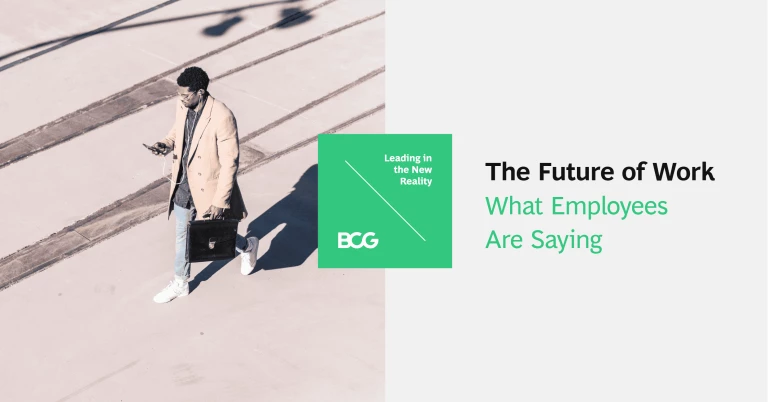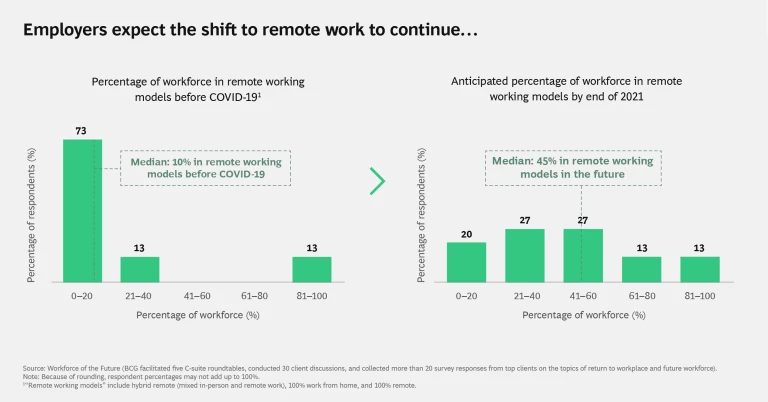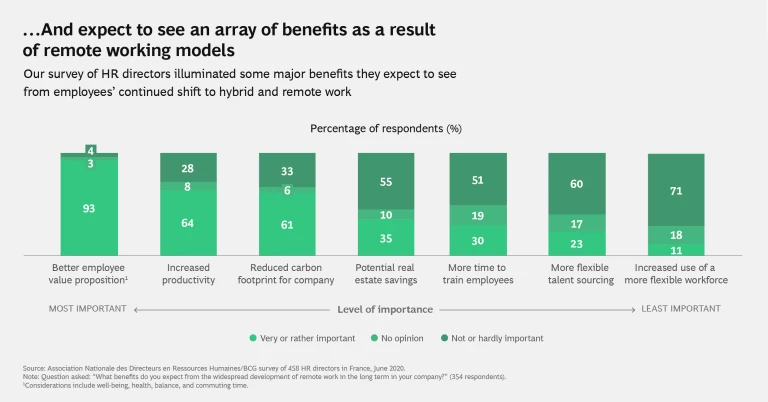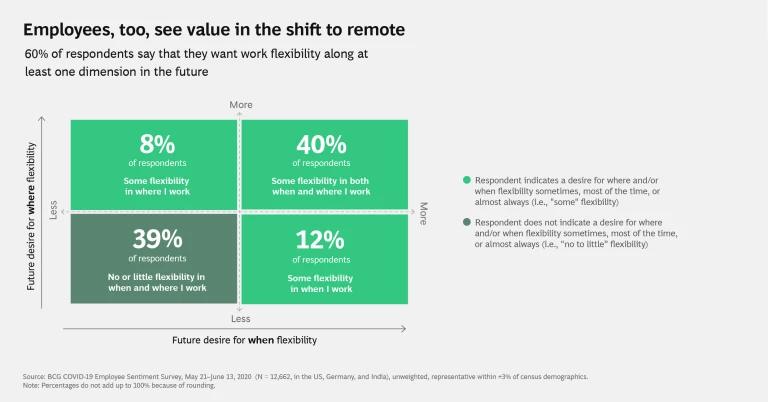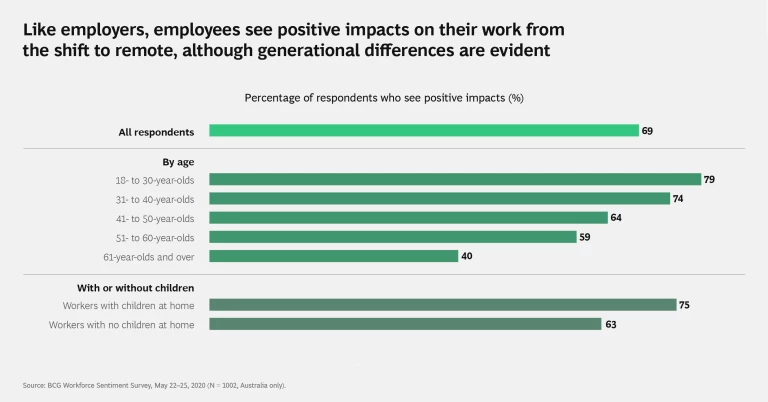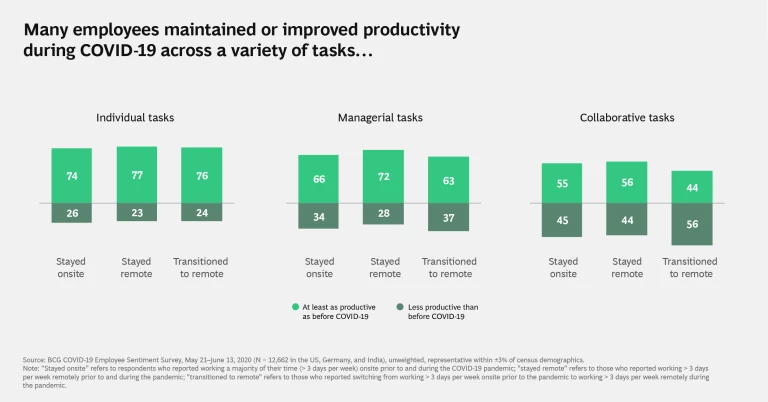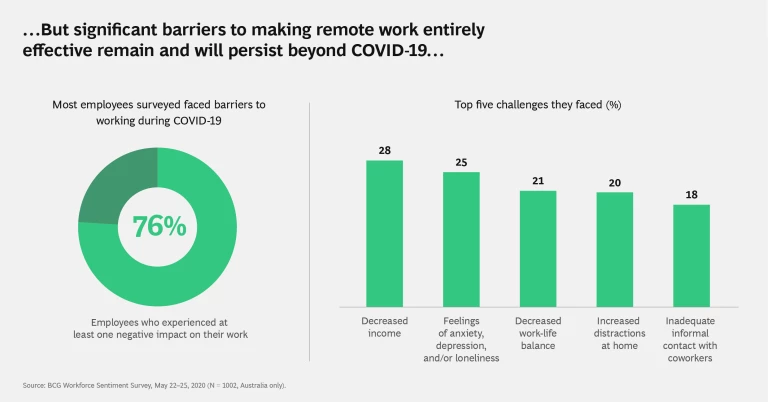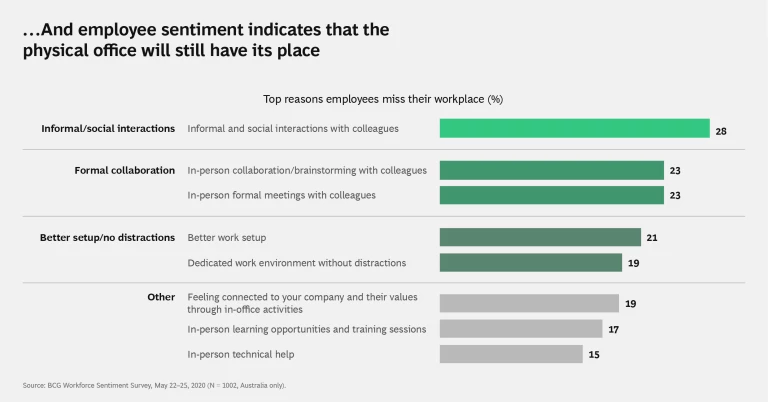Employers around the world are straddling a bridge between yesterday, when most employees at most companies were physically present at work, and tomorrow, when a vaccine or effective treatment will open the possibility of safe return to the traditional workplace. Yet even when that happens, remote work will have earned a permanent place in the employment mix.
This state of affairs presents leaders with two challenges: how to manage remote working conditions amid the uncertainty of today, and how to prepare for and optimize the hybrid working models of tomorrow, in which fully in-person and remote work will be two ends of a fluid spectrum of options. The former is a necessity; the latter, an opportunity. Hybrid work models, done right, will allow organizations to better recruit talent, achieve innovation, and create value for all stakeholders. By acting boldly now, they can define a future of work that is more flexible, digital, and purposeful.
Making Remote Work Sustainable Today
We know that remote work works. We have exhaustively surveyed employers, employees, and HR directors since the start of the pandemic, and we will continue to take their pulse as organizations experiment with new work models. Three-quarters of the employees we surveyed in Germany, India, and the US who have transitioned to or remained remote during COVID-19 say that they are at least as productive in performing their individual tasks as they were before the pandemic struck. And about half report that they are at least as productive on collaborative tasks that normally would be performed in conference or team rooms. Imagine what might be possible if organizations had the time to prepare for remote work.
We also know that remote work is unavailable for frontline workers, factory workers, and many service workers. Even apart from these serious issues of equity and fairness, remote work during a pandemic is not without challenges. Anxiety, depression, stress, and loneliness are more common than ever. Microsoft researchers who analyzed the brain waves of participants in video meetings discovered neurological activity associated with stress and overwork after just two hours. In addition, childcare obligations remain a challenge, and not everyone is set up to be productive at home. As the crisis drags on in certain countries, fatigue has settled in, too.
Until the coronavirus vanishes as a severe threat to health and safety, organizations will be managing a large share of employees who work remotely some or all of the time. Rather than default to what they have been doing for the past six months, CEOs and their executive teams can purposefully manage the increase in remote work to maximize employee engagement, well-being, and productivity. For example, when Siemens announced that it would offer two to three days of mobile working per week as a new norm, deputy CEO Roland Busch declared: “COVID-19 gives us a chance to reshape our world and reimagine work.”
Here are three forward-looking imperatives that will enable companies to properly manage the current shift to remote work and to plant the seeds for long-term value creation.
Level the playing field. Remote work is not equally possible for all employees. Especially when schools are closed or are conducting virtual classes, childcare duties often intrude on parents’ workdays—and more often on mothers’ than on fathers’. Living quarters, the presence of partners and roommates, and many other factors can influence the quality of interactions that occur during remote working. As more employees return to the physical workplace, the playing field may tilt even more sharply in favor of those who can return. If people must continue to work entirely from home, those whose homes lack adequate workspaces will be at a disadvantage. Employers can actively relevel the playing field, at both the corporate level and the team level, to ensure that all employees can succeed.
At the corporate level, no single policy or program is likely to fit all circumstances and combinations of remote and onsite work. Even in organizations where returning to the physical workplace is an option, health-vulnerable employees may need to continue to work from home until scientists develop an effective COVID-19 vaccine. So will others, either because they live with health-vulnerable individuals, are not comfortable reentering physical workplaces before a vaccine emerges, or have urgent family-care obligations.
Employers must experiment with a range of solutions to address these diverse needs and concerns. Software company Buffer offers employees a $500 stipend to help them set up their home offices, but it also reimburses coworking memberships and coffee shop working purchases, for added flexibility.
At the team level, employers should encourage each group to create shared norms to support remote work and reduce the likelihood of burnout and stress. Microsoft’s GitHub subsidiary, a software hosting company with a flat organizational structure, has been ahead of the game on this front. Even before the pandemic, GitHub’s “working manifesto” emphasized flexibility, working from anywhere, knowledge sharing, and measuring work output rather than hours. The HR department of a US media company created a similar team charter after the pandemic began, in order to align expectations and establish norms.
One norm to help level the playing field might be that, if some members of a team are working remotely, team meetings should be conducted as if everyone were working remotely—including colleagues in the office who connect from their desks. That way, members working from home would not miss out on side conversations and the dynamics of the meeting in the conference room. And everyone would be visible at full size on the screen, instead of being thumbnail-size figures in a cavernous conference room. “I understand not everyone has a home they can work from. For them, we need the office as a productive workspace. But I expect them to work as if they were at home when they come in,” the CIO of a global financial services firm told us.
Empower frontline leaders to help employees navigate the shift toward remote work. Historically, face-to-face team meetings or one-on-one coaching sessions have been the go-to tool of frontline leaders. It’s how they get to know and motivate their employees, monitor engagement in real time, and offer employees strategic context and meaning. While many leaders may naturally adjust to virtual settings, others will benefit from training and new daily routines that help them build their skills in online communication, coaching, engagement, and management of remote and hybrid teams.
Before the pandemic, many organizations were training leaders in critical fields such as emotional intelligence and building community within teams. These practices are increasingly important, especially for colleagues who have joined the team during the pandemic. Our survey of employees in Germany, India, and the US found that employees satisfied with social connectivity at work are on average 2.5 times as likely to say that their productivity is at least as high now as it was before the pandemic. (See Exhibit 1.)
Best practices are emerging. At a large insurer whose agents traditionally conducted business in person, managers have created virtual team sessions in which agents encourage one another as they make phone and video sales calls: They work on mute but watch one another. They dance on screen, clap, and video high-five when a colleague completes a sale. They can also raise their hand and talk privately with their team leader to obtain just-in-time coaching.
Organizations should also identify frontline leaders who are innovating and experimenting on their own with new tools, routines, and approaches to managing remote and hybrid teams. They can then enlist them in a “best teach the rest” model to teach their peers how to optimize the effectiveness of remote working.
Continue caring. In the early days of the pandemic, many employers adopted or promoted programs to support mental health, physical health, social connectivity, collaboration tools, and family care. Now is not the time to let up on this care and compassion.
The potential costs of remote work—especially burnout—are as real as the benefits. Employers must continue to develop programs and policies that create an empathetic culture centered on employee wellness. A fantastic example is IBM CEO Arvind Krishna’s work-from-home pledge, which outlines the company’s commitment to balancing work and home commitments.
Another great example from the early days of the pandemic involves Broad Institute of MIT and Harvard, which focuses on improving human health by using genomics to advance our understanding of the biology and treatment of human disease. Broad Institute set up a subsidized daycare program to help parents manage work and family. Frances Taplett, chief people officer, told the Boston Globe that she intends to build on this initiative by creating a menu of options. “How do you bring your best self to work?” she said.
The Broad Institute has the unusual advantage of being able to process COVID-19 tests at an in-house lab, which it set up to support public health needs across Massachusetts. As a result, it can offer regular COVID-19 testing to participating parents and teachers. Although most organizations may not be able to do this, they can give their employees a wider array of options for how and when they work, so long as their output remains high. They can allow teams to establish email-free times, for example, or establish prearranged time blocks for meetings and let employees accomplish nondeadline work when it best suits their schedule.
Reimagining Work After the Virus
Pandemics eventually subside, but the imperatives listed above will remain true. Our surveys over the past months indicate that employees and employers alike have little interest in returning to pre-pandemic work models. By the time the coronavirus has receded, however, it will be too late to begin reimagining and redesigning work. Farsighted employers have already started to capture the value presented by this opportunity to catapult themselves into a post-COVID-19 world. They are reimagining the future of work by creating new work models based on four building blocks. (See Exhibit 2.)
Leadership, Culture, and Purpose. The virus has brought out the best in many organizations, magnifying strong leadership practices. Companies leaned on their purpose to guide decision making. Moving forward, leaders must ask: What is the best way to bottle this coronavirus-forged culture and prevent sliding back into hierarchical, risk-averse, siloed ways of working?
In the teeth of the pandemic, with its employees working remotely, a traditional media and entertainment company began a project to supercharge its digital capabilities. Liberated from the physical silos of their fragmented offices, the company’s leaders leaped to unlock a more collaborative, nimble culture. They started with the galvanizing goal of embracing digital platforms to better serve a customer base with digital services—a transformation that required close cooperation between largely isolated engineering and business units. Leaders created pilot agile teams with engineering and business members and gave team leaders unprecedented autonomy to rapidly develop new products and features that meshed with the company’s broader business objectives.
This top-down focus on meaningful objectives and bottom-up empowerment helped transform the pilot teams’ culture. When they worked in an office, engineering and business people rarely crossed paths; but given new ownership of shared goals, they are working more closely than ever before, despite doing so virtually. Team members have remarked on the boost of energy they feel from having every conversation focused on the end user, and from connecting every day with colleagues in different functions whom they rarely spoke to otherwise. The new teams are building an advanced media trends analytics product at record pace. Iterations that used to take six months to build now take six weeks. “There’s no way back. We need to bring the entire technology organization to this way of working,” the company’s CIO said.
Structure and Roles. The pandemic unfolded just as organizations were starting to become bionic, intertwining technology, technology platforms, and human capability to power growth, innovation, efficiency, and resilience. Farsighted organizations are doubling down on bionic structures to take advantage of the emerging hybrid work norm. A leading health insurance company had already started to reinvent its structure around supporting end-to-end customer journeys. Although this transformation began before the pandemic, its value has increased as the company positions itself to capitalize on more fluid onsite and remote work arrangements. For example, new member experience managers will coordinate with local care delivery teams so that members who seek treatment anywhere in their broader coverage area get the same quality of service, whether they are close to home or at a satellite office on the road. Internal systems are migrating to the cloud, giving back-office employees quick access to the same data from any location. This permits the insurance company to reorganize support functions across multiple headquarters in different cities, unlocking new cost-saving opportunities from a more geographically flexible workforce.
Ways of Working. Forced to work remotely, organizations figured out on the fly what worked and what did not during the pandemic. They experimented. They learned. They became more agile without committing to a big new program or manifesto. Many of them created swat teams that embodied the principles of agile—empowered, cross-functional teams; rapid decision making; and experimentation—because the crisis was larger and more demanding and required faster responses than traditional hierarchies could generate. They learned how to work around agile’s principle of co-location. Instead of co-locating team members in the same room, they arranged through technology to situate them in the same virtual room—and now the daily ceremonies of agile (such as standups and checkouts) help fuel collaboration remotely, proving that agile methodologies enable remote to be productive.
A leading health-care and hospital system that had sent thousands of administrative employees home during the early days of the pandemic completely rethought their ways of working before employees returned. Rather than imposing a uniform model, the health-care system listened carefully to employee needs, as expressed in surveys, interviews, and meetings.
Some teams wanted to come in once every couple of weeks for planning meetings, while others wanted to brainstorm and make connections in person two or three days a week. Collecting rich data on the employee experience enabled the hospital system to create highly tailored working models to help each team achieve peak performance.
Systems and Spaces. Changes in ways of working imply changes in workplaces. The health-care system discussed above will save tens of millions of dollars in real estate costs, but it is doing more than shrinking the traditional office. It is rolling out smart meeting rooms—and even smart, sensor-equipped desks and chairs—so that individual employees can book exactly the space they need at the time they need it for the type of work they need to do.
Organizations must make these kinds of investments in digital infrastructure to get the most value out of a flexible location strategy. For example, the insurance company Nationwide has been able to accelerate its plan to close a number of small offices because, for years, its leaders have been implementing new digital systems and collaboration tools to support hybrid work models. Investing in smart workspaces, digital information systems, and cybersecurity tools can provide net cost savings while giving employers and employees greater flexibility in where and how they do their work.
COVID-19 has pushed organizations into an unprecedented and unplanned experiment in remote and hybrid work. Even when the experiment ends, following mass deployment of a vaccine or treatment, the key findings of this experiment will endure. Hybrid work is here to stay. The challenges of these new models are real, but so are the opportunities to reduce real estate costs, supercharge productivity and engagement, and develop a new level of customer intimacy. Organizations that create a level playing field for all workers, regardless of their location, empower frontline leaders, and continue to make caring for employees their highest priority can holistically re-create their work model—not only structurally but in ways of working, workspaces, and culture—to win the future of work.
The authors would like to thank the panel of BCG experts who contributed insights to this article: Sonia Brodski, Adriana Dahik, Julia Dhar, Lucas Du Croo De Jongh, Roy Gottesdiener, Josh Kellar, Adam Kotsis, Caroline Kreafle, Ania Labno, Chris Mattey, Reinhard Messenboeck, Penny Metchev, Derek Newberry, Ernesto Pagano, Pedro Pereira, Mukund Rajagopalan, Benjamin Rehberg, Prateek Roongta, Michelle Russell, Prasanna Santhanam, Benoit Serre, Abhishek Shroff, Nicole Sibilio, Nick South, Rainer Strack, Liza Stutts, Tatsuya Takeuchi, and Robert Werner.
They would also like to thank Jon Kaplan, Rob Kurtz, and Christoph Schmidt for their contributions.

